数词介词的用法图文稿
介词的用法PPT课件
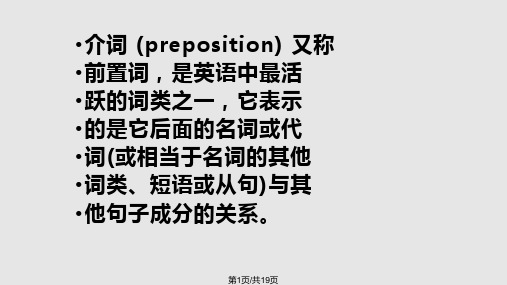
• work out 算出 • help sb. with sth.在……方面帮助 • play with snow玩雪 • with one‘s help在某人的帮助下 • with the help of …在…的帮助下 • with a smile 面带笑容 • chat with和…聊天 • argue with sb. 与某人争论 • make friends with 和…交朋友 • go to the hill with sth.带着东西上山 • get on well with sb.和某人相处的很好
第3页/共19页
•注意点: •☆介词不能单独充当句 •子成分,它必须与名词 •或相当于名词作用的成 •分构成介词短语才能充 •当句子的成分。
第4页/共19页
•词组中与at的搭配
第5页/共19页
• be good at 精通于 • be angry at 对 (事) ……发怒 • laugh at 因……而发笑 • at the best 充其量 • at first 开始 • at least 至少,起码 • at length 最后,终于 • at once 立即,马上 • at present 现在 • at rest 休息,静止不动 • at times 间或,有时
第15页/共19页
• have an argument with sb.与某人争吵 • have a fight with sb与某人打架 • be popular with sb.受某人欢迎 • say with a smile微笑地说 • be filled with充满 • catch up with sb.赶上某人 • chat with sb.和某人闲谈 • be strict with sb.对某人要求严格 • offer / provide sb. with sth.给某人提供某物 • sb. spend sometime with sb.花了多少时间陪谁
介词的用法区别、冠词、数词、名词、形容词、动词
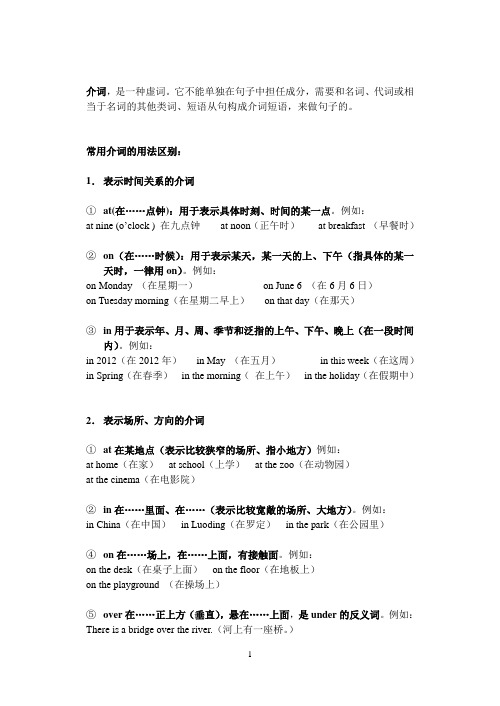
介词,是一种虚词。
它不能单独在句子中担任成分,需要和名词、代词或相当于名词的其他类词、短语从句构成介词短语,来做句子的。
常用介词的用法区别:1.表示时间关系的介词①at(在……点钟):用于表示具体时刻、时间的某一点。
例如:at nine (o’clock ) 在九点钟at noon(正午时)at breakfast (早餐时)②on(在……时候):用于表示某天,某一天的上、下午(指具体的某一天时,一律用on)。
例如:on Monday (在星期一)on June 6 (在6月6日)on Tuesday morning(在星期二早上)on that day(在那天)③in用于表示年、月、周、季节和泛指的上午、下午、晚上(在一段时间内)。
例如:in 2012(在2012年)in May (在五月)in this week(在这周)in Spring(在春季)in the morning(在上午)in the holiday(在假期中)2.表示场所、方向的介词①at在某地点(表示比较狭窄的场所、指小地方)例如:at home(在家)at school(上学)at the zoo(在动物园)at the cinema(在电影院)②in在……里面、在……(表示比较宽敞的场所、大地方)。
例如:in China(在中国)in Luoding(在罗定)in the park(在公园里)④on在……场上,在……上面,有接触面。
例如:on the desk(在桌子上面)on the floor(在地板上)on the playground (在操场上)⑤over在……正上方(垂直),悬在……上面,是under的反义词。
例如:There is a bridge over the river.(河上有一座桥。
)冠词、数词冠词要用在名词前面,用来说明名词所指的人或事物是泛指还是特指。
冠词是一种虚词,不能单独作句子成分。
冠词分为不定冠词a/an和定冠词the。
数词、连词、介词、形容词和副词

数词、连词、介词、形容词和副词专题四数词数词是中考必考的⼀个语法点,基数词,序数词,分数⼀、数词的分类数词主要分为基数词和序数词两类。
1. 基数词表⽰数⽬的词称为基数词。
其形式如下:A.从1——10:one,two,three,four,five,six,seven,eight,nine,ten.B. 从11-19:eleven,twelve,thirteen,fourteen,fifteen,sixteen,seventeen,eighteen,nineteen.这⾥除eleven,twelve,thirteen,fifteen,eighteen为特殊形式外,fourteen,sixteen,seventeen,nineteen 都是由其个位数形式后添加后缀-teen构成。
C.从21——99:整数⼏⼗中除twenty,thirty,forty,fifty,eighty为特殊形式外,sixty,seventy,ninety 都是其个位数形式后添加后缀-ty构成。
表⽰⼏⼗⼏时,在⼏⼗和个位基数词形式之间添加连字符“-”①21 twenty-one ②76 seventy-sixD.百位数:1-9基数词形式加“hundred”,表⽰⼏百,在⼏⼗⼏与百位间加上and.101 a hundred and one 320 three hundred and twenty 648 six hundred and forty-eightE.千位数以上:从数字的右端向左端数起,每三位数加⼀个逗号“,”。
从右开始,第⼀个“,”前的数字后添加thousand,第⼆个“,”前⾯的数字后添加million,第三个“,”前的数字后添加billion。
然后⼀节⼀节分别表⽰,两个逗号之间最⼤的数为百位数形式。
①2,648 two thousand six hundred and forty-eight。
②16,250,064 sixteen million two hundred and fifty thousand sixty-four。
英语各种介词的区分和使用(共25张)PPT课件

1. in summer, on September 1st 2. at the cinema, in the hospital 3. write with a pen, go by bus 4. about him, made of wood
时间 地点 方式
其它
CHENLI
4
时间介词
in 年、月、季节及时间段(早、午、晚) on 具体某一天,星期、节日 at 钟点、节日、(一段时间)的起点
在圣诞节期间
by 2016(完成时)
在2016之前
before three days
三天之前
after three days (过去时、一般时) 三天之后
in three days (将来时)
for three days(完成时)
有三天
since three days ago(完成时) 自从三天前
for + 时段
A. in , in B. at ,at C. in, at
CHENLI
9
例题4
Mr. Brown has gone to Canada. He will be back ___ two weeks.
A. for B. after C. in
CHENLI
10
例题5
Our manager came back ___ an hour.
方式介词
1. in 用材料、语言、声音、方式 2. with 用工具、某物 3. by 用方法、交通工具
CHENLI
21
例题1
My mother often go to work ___ bike.
A. in B. on C. by
介词的用法PPT课件
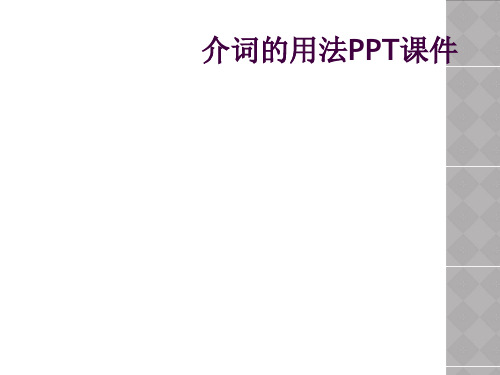
(2) on:用于星期,某天,某一天的上午、下午、晚上(指具体的 某一天时,一律用)
On Sunday在星期天 on Sunday morning 在星期天的上午 on March 8 在3月8日
(3)in:用于表示周、月、季节、年、泛指上午、下午、晚上。 in 1999 在1999年 in November 在11月份 in summer 在夏季 in the afternoon在下午 过……后(未来时间) I think he will be back in an hour .我想他一小时后就会回来。 I heard that she would be back in a month.我听说她一个月
(5)between ,among ,around
①between:在两者之间 The differences between American English and British
English are not very great .美国英语和英国英语之间的差别不是 很大。
②among:在三者或者更多的之中 There are some American students among us .在我们中间
②behind :在…..后边 Are there any cows behind the house ?房子后面有一些牛吗?
(7)in ,into ,out of
①in:在…..之内,用于表示静止的位置 There are four girls in the room.房间里有4个女孩。 ②into:进入,用于表示有特定终点的运动方向,通常用于表示动作
3、表示手段和材料的介词用法
1)with ①和……在一起 These plates keep moving ,like great ships ,carrying the
数词及其用法PPT课件
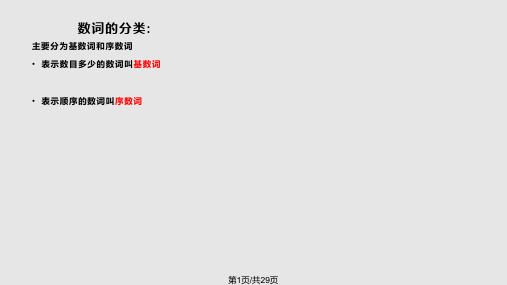
• 如:a No.5 bus
•
the No.8 bus
第12页/共29页
练习
. We are going to have a basketball match
with _____.
A. Class First
B. Class One
C. First Class
D. Class the First
第13页/共29页
解析:考点:确数和概数的表达。 确数:数词+计量名词(不能加S) 概数:计量名词+S + of
第6页/共29页
类比练习
1. Shortly after the accident, two _____ police
were sent to the spot to keep order.
A. dozens of B. dozens
• B.从 11--19 eleven,twelve, thirteen, fourteen, fifteen, sixteen, seventeen,eighteen, nineteen.
这里除 eleven, twelve, thirteen, fifteen, eighteen为特殊形式外 ,其余 都是由其个位数形式后添加后缀-teen构成 .
• 形式分别为:the +序数词 + 名词;名词 + 基
数词。如:the First World War或World War
One,
Lesson 8 =the eighth lesson
• ②对于一些大序号我们通常只用一种表达法,
• 即名词 + 基数词。
• 如:Room 501, Bus 538。
高三英语数词、介词和连词(PPT)2-2
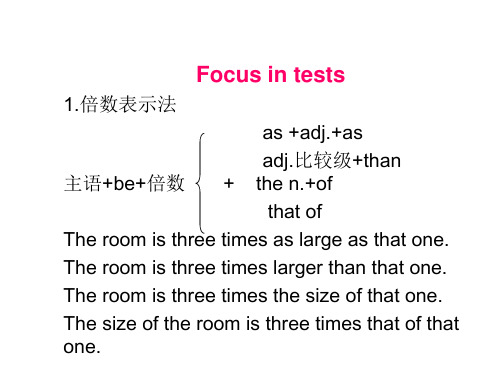
of, • in charge of,in favor of,in addition to,in touch
with,in the absence of,in exchange for,
comparision with,in contrast with(to)
;祛斑 怎么祛斑 如何祛斑 https:/// 祛斑 怎么祛斑 如何祛斑
来自美国、英国、南非等国15个研究机构的天文学家参与研究,团队利用南非MeerKAT射电望远镜阵列捕捉到这对巨型“孪生”气泡状结构发出的射电波。这一巨大的沙漏形结构从银河系中心向上下两个方向各延伸数百光年。 通过分析这对巨型气泡的尺度和形态,天文学家认为,这很可能是数百万年前发生在银河系超大质量黑洞附近一次短时间猛烈能量爆发的结果。 [1] 10月8日消息,一张由哈勃望远镜的近红外照相机和多目标光谱仪(NICMOS)拍摄的银河系中心的假彩色合成图片。这张美国宇航局哈勃太 空望远镜红外镶嵌图像是迄今为止对银河系中心最清晰的图片。它显示了新的大质量恒星群,以及天体中央在300×115光年左右的炎热的电离气体下的复杂结构细节,银河系核心在红外线可穿过的可见光中被尘埃云遮盖。新的NICMOS数据显示出电离氢气以及大量散布在该区域的大质量恒 星。来自这个复杂结构中心的恒星风和辐射一定情况下,它们可能引发新一代恒星。在左上角,大圆弧的电离气体分解成有趣的线性队列表明该处是强大磁场影响的临界位置。左下角区域表明在五合星团中炙热的大质量恒星风雕刻成的气注。图像中间电离气体环绕在银河中心的黑洞周围 ,形成了一个嵌在管状环内的明亮螺旋。 共生星是一种在光谱中既出现低温吸收线又出现高温发射线的恒星。1941年梅里尔首先把这种光谱性质很不相同但又互为依存的星取名为共生星。它们的光变具有准周期的类新星爆发特征,并有小振幅的快速非周期光变。1969年博亚尔丘克提出共生星的三个判据:①晚型星光谱的吸收线 (如TiO带,CaI,CaⅡ等)。②HeⅡ、OⅢ或更高电离电位原子的发射线(发射线的宽度不超过每秒 100公里)。③亮度的变化在几周内达到3个星等。2014年,已发现的共生星约有50颗(包括不肯定的),典型星是仙女座Z。 共生星的光度与谱变有一定的相关性:往往当光度增强时,晚型吸收谱和高激发发射线减弱或消失,B型气壳谱增强;当光度变弱时,晚型吸收谱和高激发发射线又重新出现或加强。共生星的空间分布与行星状星云相似,集中在银道面附近,属年龄较老的盘星族。 共生星是单星还是双星一直是有争论的。单星说认为共生星是小而热的蓝星,周围有一个变化的星周壳层。双星说认为共生星是由一颗晚型冷星和一颗低光度的热星组成的,它们有一个共同的气体包层;假定冷星是正常巨星,则热星在赫罗图上位于主星序的下方,与行星状星云的中心星 、某些新星的热子星位置相近。 你听说过这样一个奇怪的星体吗?早在20世纪30年代,天文学家在观测星空时发现了一种奇怪的天体。对它的光谱所做的分析表明,它既是“冷”的,只有几千摄氏度;同时又是十分“热”的,达到几十万摄氏度。也就是说,冷热共生在同一个天体上。1941年,天文学界把它定名为共生 星。它是一种同时兼有冷星光谱特征(低温吸收线)和高温发射星云光谱(高温发射线)的复合光谱的特殊天体。几十年来人们已经发现了约100个这种怪星。许多天文学家为了解开怪星之谜耗费了毕生精力。 最初,一些天文学家提出了“单星”说。他们认为,这种共生星中心是一个属于红巨星之类的冷星,周围有一层高温星云包层。红巨星是一种晚期恒星,它的密度很小,体积比太阳大得多,表面温度只有二三千摄氏度。可是星云包层的高温从何而来,人们还是无法解释。太阳表面温度只 有6000℃,而它周围的包层——日冕的温度却达到百万摄氏度以上。能不能用它来解释共生星现象呢?日冕的物质非常稀薄,完全不同于共生星的星云包层。因此,太阳不算共生星,也不能用来解释共生星之谜。 也有人提出了“双星”说,认为共星是由一个冷的红巨星和一个热的矮星(密度大而体积相对较小的恒星)组成的双星。但是,当时光学观测所能达到的分辨率不算太高,其他观测手段尚未发展起来,人们通过光学观测和红移测量测不出双星绕共同质心旋转的现象。而这是确定是否为双星 的最基本物质特征之一。随后,天文学家用x射线、紫外线、可见光、红外线到射电波段对共生星进行了大量观测,积累了许多资料,共生星之谜逐步揭开。
初中英语语法—介词(26张)PPT课件
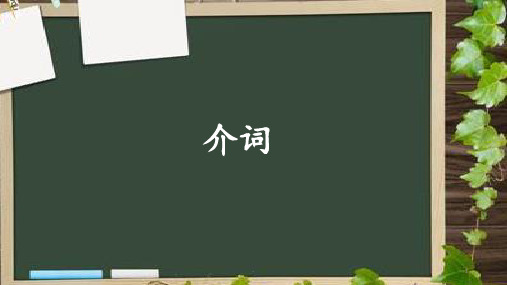
-
1
介词的分类方时 地式间 点介介 介词词 词
介词介词短语b动介e+词词形++容介名词词词+介词
介词的功能定 表语 语
状语 宾语
-
2
1.表时间时,at强调“点”,in强调“段”,on强调“日”和某日的早、中、晚。 I got there at eight this morning. 今天早上我八点到那。
-
5
The teacher had already started teaching by the time she got to class. 当她到班级的时候老师已经开始讲课了。 6.表地点时,in表示“范围较大的地方”,强调“空间”;at表示在“范 围较小的地方”,强调“点”。 I live in China. 我居住在中国。 We often wait for the bus at the bus stop. 我们通常在公共汽车站等车。 7.表位置时,in表示“在……内”,on表示“在……上”(接触表面), on还可以表示“在两边”“在左/右边”。
-
8
The sunshine got into the room through the glass. 阳光透过玻璃进入房间。 11.behind表示“在……的后面”,其反义词组“in front of”表示“ 在……的前面”,注意与in the front of 的区别。 We must keep our hands behind our backs. 我们必须一直把手放在背后。 I was walking down the street when a friend of mine stood in front of me. 当一个朋友站在我面前时,我正沿着街道散步。
初中英语数词用法(共19张PPT)
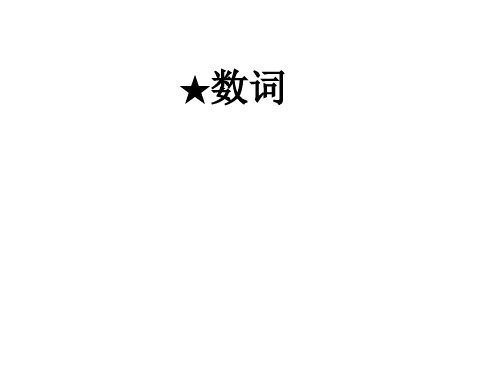
五、编号
一般编码用 名词 + 基数词
207房
Room 207
三年级一班 Class one Grade three
第五部分
part five = the fifth part
第一课
lesson one = the first lesson
3 号汽车
Bus No.3 = the No.3 bus
第一中学
序数词构成规律口诀
基变序,有规律, 一二三特殊记,词尾字母t, d, d, 加th从4起,(fourth, sixth) 八去“t”,九去“e”, “f”来把“ve”替,(fifth, twelfth) 单词“ty”作结尾,“ty”变成“tie”, (twentieth, thirtieth,…ninetieth) 若是遇到几十几,只变个位就可以。(fifty-fifth) 序数词缩写记清楚,数字后跟两字母 (first—1st second—2nd third—3rd fourth—4th twentieth—20th twenty-third—23rd ).
3
1 3
基数词 + and + 分数 three and one third
80 % 基数词 + percent
eighty percent
half / (百)分数 + of + 可数名词复数 谓语动词用复数
half / (百)分数 + of + 不可数名词 谓语动词用单数
3.78 three point seven eight
50% fifty percent
百分之五十
percent不用复数形式。
数词的表示法 — 分数百分数
高中英语语法之数词的用法 (共44张PPT)
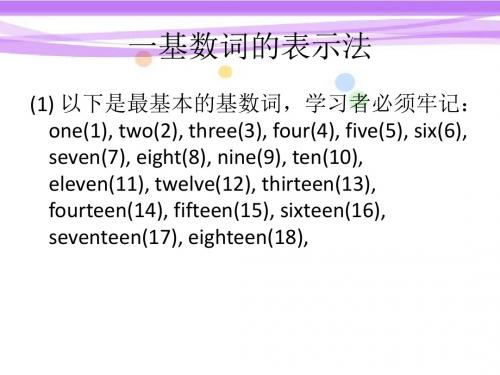
• 不过,像1500这样的年份可以有两种读法 one thousand five hundred和fifteen hundred, 而2000年通常读作 two thousand,2003年读 作 two thousand and three。
•
若表示某个某个年代,则按类似以下 的读法:1980s 读作nineteen-eighties(20世 纪80年代), 1600s 读作sixteen hundreds(17 世纪头10年,即1600—1610), 比较:1300 thirteen hundred(1300年)。
• (3) 某些习语中也用复数形式的基数词: • in [by] twos and threes 三三两两地 at sixes and sevens 乱其八糟
二、序数词
• 1. 序数词的表示法 • (1) 以下是最基本的序数词,学习者必 须牢记:first(第1), second(第2), third(第3), fourth (第4), fifth(第5), sixth(第6), seventh(第 7), eighth(第8), ninth(第9), tenth(第10), eleventh(第11), twelfth(第12), thirteenth(第 13), fourteenth(第14)
• 3. 用于复数形式的基数词 • (1) 表示整十的基数词用复数形式可以 表示人的岁数或年代: • in the sixties 在60年代 in one's thirties 在某人30多岁时
• (2) 基数词转化为名词,可用复数形式: • How many twos are there in ten? 10里面 有几个2? • The soldiers marched in tens. 士兵们10 人一排前进。
介词冠词和数词的用法总结

介词冠词和数词的用法总结《介词冠词和数词的用法总结》整体感受嘛,介词、冠词和数词在英语学习里真的是有点让人头疼,但又很重要的部分。
就像建房子的小零件,虽然小但缺了它们房子就不稳固。
先来说说介词。
回想起来才发现介词用法超级多。
比如说“in”、“on”和“at”,这三个太常见了。
“in”可以表示在一个空间里面,像“in the room”,在房间里;还可以表示在一段时间范围内,“in the morning”在早上。
“on”呢,经常用在具体的某一天,“on Monday”,星期一这一天。
“at”就更多用于具体的时间点,“at 7 o’clock”。
而且介词和动词搭配起来还有很多特殊的用法,像“look at”看,“listen to”听。
这些搭配可不能搞错,这就像钥匙和锁,一对一搭配好才能打开正确的理解大门。
冠词分定冠词“the”和不定冠词“a”、“an”。
“a”和“an”表示一个或者某一个,“an”用在元音开头的单词前,比如说“an apple”。
“the”的话就特指某个事物,比如说“the book”,就是特定的那一本书。
这让我想起之前做练习题的时候,就老在定冠词和不定冠词上犯迷糊。
有一次看到句子“Give me a book”和“Give me the book”,当时就没分清。
现在想想,第一个句子只是说给我一本书(随便一本),而第二个句子是给我那本(特定的那本)书。
原来是这么回事。
数词相对来说比较简单,但容易出错的点也有。
基数词就是表示数量,“one”“two”“three”之类的。
序数词表示顺序,像“first”“second”“third”。
这里有个特别要记住的点,序数词前面一般都是要加定冠词“the”的,比如说“the first day”第一天。
重要发现呢,就是这些词的用法有时候是要根据上下文来判断的。
不能只看单词本身就确定怎么用,一定要把整个句子或者段落的意思弄明白。
反思一下,之前对于它们的学习有点太死记硬背了,没有深入去理解每个用法背后的逻辑。
- 1、下载文档前请自行甄别文档内容的完整性,平台不提供额外的编辑、内容补充、找答案等附加服务。
- 2、"仅部分预览"的文档,不可在线预览部分如存在完整性等问题,可反馈申请退款(可完整预览的文档不适用该条件!)。
- 3、如文档侵犯您的权益,请联系客服反馈,我们会尽快为您处理(人工客服工作时间:9:00-18:30)。
数词介词的用法集团文件发布号:(9816-UATWW-MWUB-WUNN-INNUL-DQQTY-代词用法详解(人称代词)人称代词主格:作主语,表示谁怎么样了、干什么了。
I am a teacher.You are student.人称代词宾格作宾语,表示动作行为的对象,一般放在动词后面。
Give it to me.巩固训练用所给代词的正确形式填空。
1. These are ______ ( he ) brothers.2. That is _______( she ) sister.3. Lily is _______ ( Lucy ) sister.4. Tom, this is _____ ( me ) cousin, Mary.5. Now _____________(her parent) are in America.6. Those __________ ( child ) are _____ ( I ) father’s students.7. Do you know ______ ( it ) name?8. Mike and Tom __________ ( be ) friends.9. Thanks for helping ________( I ).10. ______(Ann安)mother is ______(we) teacher.物主代词:形容词性物主代词(my/your/his/her/its/our/their)+名词而名词性物主代词(mine/yours/his/hers/its/ours/theirs则相单于形容词性物主代词+名词,故其后不必加名词。
如:Is this your book No, it isn’t,it’s hers(her book) ,Jim’s ,Tom’s,Maria’s1.补全对话----Whose bike is it Is it______(your/yours)----No, it’s not______.(my/mine) _______is red. But this bike is blue .----Is it Jane’s----Sorry, I don’t know. Maybe it’s_______(her/hers).----Jane,is this______bike (youryours)----No,it’s not______.(my?mine) You can ask Bill(男人名).Maybe it’s________.(him/his)----Bill,is this bike_______----Oh,yes,it’s_______bike. Thank you very much!2. 填入正确的人称代词和物主代词1.Thisisn’t________knife._________isgreen. ( she )2.Theseareyourbooks,Kate.Put__________inthedesk,please. (they )3._______mustlookafter________things. ( you )4.WeiFang,isthat________rulerYes,it’s.( you )5.Theywantafootball.Give__________thegreenone,please.( they)6.It’sLinTao’sbag.Giveitto__________. ( h e )7.Isthispencil-boxLiLei’sNo,___________isverynew. ( he )8.Thisboxistooheavy.Ican’tcarry_________.( it )Don’tworry,Let__________( I )help__________. ( you)9._____isaboy_____nameisMike.Mike’sfriendslike_____verymu ch. ( he )10.Mysisterisin_____room._____isateacher. ( she )11.Janeisalittlegirl._____motherisanurse. ( she )12.Wearein_____classroom._____classroomisbig. ( we)13.Myfatherandmotherareteachers._____arebusy ( them)数词表示"多少"和"第几"的词叫数词。
其用法相当于名词或者形容词。
数词分为基数词和序数词两种。
基数词 1-12 是独立单词,需逐个记忆。
基数词13 - 19是个位数词的词干后加-teen 构成。
其中 thirteen, fifteen, eighteen变化不规则。
基数词20 ━90 是在十位数词后面加 -ty 构成。
基数词 21 ━ 99 是在十位数词后面加上个位数词合成,中间加上连字符 " - "; 基数词三位以上的数词, 在百位和十位之间,一般要用连词"and "。
例如:21 twenty –one 95 ninety - five132 one hundred and thirty-two 1340 one thousand three hundred and forty表示"万"的词英语中没有。
如1万可用10千来表示。
ten thousand30万可用 three hundred thousand 来表示。
注意:基数词one, two, three等与hundred, thousand, million, billion连用时hundred, thousand, million, billion后不加s, 如:two hundred, five million; 当不确定数词some, many与hundred, thousand, million, billion连用时hundred, thousand, million, billion后要加s,且后接of, 如:hundreds of; thousands of; millions of; billions of。
2.序数词:表示数目顺序的词用序数词。
1) 序数词1━19 除第一,第二,第三,第五,第八,第九, 第十二变化不规则外,其余均在基数词后加上 -th。
2) 十位整数的序数词的构成方法是将十位整数基数词的词尾 -y 变成i 再加 -eth。
3) 几十几的序数词,只是把个位数变成序数词,十位数不变。
4) 第一百以上的多位序数词,由基数词的形式变结尾部分为序数词形式来表示。
one hundred and twenty-first 第一百二十一one thousand,three hundred and twentieth 第一千三百二十5)序数词的缩写形式:有时,序数词可以用缩写形式来表示。
主要缩写形式有:first—lst second—2nd third—3rd fourth—4thsixth—6th twentieth—20th twenty-third—23rd其中lst,2nd,3rd为特殊形式,其它的都是阿拉伯数字后加上th。
6)序数词前往往要用定惯词“the”。
The second is what I really need.第二个是我真正需要的。
We are to carry out the first plan.我们将执行第一个计划。
注:序数词在使用时,通常前面要加定冠词 the;但是如果序数词前出现不定冠词a或an时,则表示“再——”,“又——”。
We'll go over it a second time.我们得再念第二遍。
7)基数词也可以表示顺序。
只需将基数词放在它所修饰的名词之后(名词需大写) 即可,不需要添加定冠词。
the first lesson——Lesson One the fifth page——Page 5(five)the twenty-first room——Room 21(twenty-one)3.数词的特殊用法1) 加减乘除的表达One plus two is three. 一加二等于三。
Eight minus four is four. 八减四等于四。
Two times two is four. 二乘二等于四。
Ten divided by two is five. 十除以二等于五。
2) 表示倍数This river is two times longer than that one. 这条河比那条河长两倍。
3) 表示百分数Thirty percent of them is water. 它们当中有30%的水。
Eighty percent of what he said is true. 他的话有80%是真实的。
4) 表示分数时,分子数字用基数词, 但分母要用序数词, 如分子不是1,序数词要用复数形式。
One fifth of the books are mine. 五分之一的书是我的。
Three-tenths of water is disappeared. 十分之三的水不见了。
5) 小数5.5 读作five point five 12.135读作 twelve point one three five专项练习:( )1. There are days in a year. A. threehundreds sixty-five B. three hundreds andsixty-five C. three hundred and sixty-five D. three hundred and sixty five( )2.He always wanted to have of books and he has recently bought four .A. hundreds...hundredsB. hundred...hundredC. hundreds...hundredD.hundred...hundreds( )3. Look! There are in the sky.A. thousand starsB. thousand of starsC. thousands of starsD. thousands of star( )4. He will come here tomorrow morning.A. at fifthB. at tenC. ontwo D. till tenth( )5. He began to live there .A. on his fiftyB. at age of fiftyC. when he fiftyD. in his fifties( )6. There are months in a year. December isthe month of the year.A. twelve; twelveB. twelve; twelfthC. twelfth; twelveD. twelve; twelveth( )7. Sunday is the day of the week.A. seventhB. firstC.second D. third( )8. What's the date today---It’s .A. FridayB. time to goC.cloudy D. June 4th( )9. Jenny was born .A. on July 10, 1987B. inJuly 10, 1987C. in 1987, July 10D. on1987, July 10( )10. About of the books in our school libraryare written in Chinese.A. four-fifthB. four-fifthsC.fourth-fifths D. fourths-fifth( )11. of the world's books and newspapers arewritten in English.A. Three quartersB. Three quarterC.Thirds four D. Threes fourth( )12. Tom is in the row.A. a secondB. the secondC. twoD. second( )13. I’ve been Hainan twice. I want to go theretime. A. the others B. a third C.other D. the third( )14. of the students are girls in our class. A.Two three B. Two threes C. Two thirds D.Second three介词1.about1)关于,对于 I know nothing about it.2)大约,左右 She is about 60 years old.3)在……周围 There are many trees about the lake.2.above1)位于……的上方 They live in a flat above the shop.2)超过,多于Today’s temperature is 12℃ above zero.3.across1)穿过,超过 He swam across the river.2)在……的对面 The bus stop is across the road.4.after1)在……之后,在……以后 We will talk about the matter after dinner.2)在……后面,模仿,按照 Read after me.The children went into the office after the teacher.5.along 沿着,顺着 We walked along the bank of the river. 6.among在……(三者或三者以上的)中间,在……当中He is the tallest among these the boys. The village is among the mountains.7.around1)在……的范围内,在……的各处 They showed us around the factory.2)在……周围(同round,),围着 They sat around the fire. 8.at1)在(较小的范围) The post office is at the corner of the street.2)(表时间或时候)在 The film began at seven thirty.3)对……,向…… The manager is shouting at him.Mother always looks at me with love in her eyes.4)在……方面 He is good at English.9.as 作为 He works as a worker in that factory.10.before1)(位置)在……前面 He stood before me.2)(时间)在……之前 We usually get up before six in the morning.11.behind1)(位置)在……后面 There is a garden behind the house.2)迟于,晚于, The train was behind the time.12.beside在……旁边 He sits beside me.13.besides除……之外(还) I have got several other friends besides you.14.by1)被……,由…… The story was told by one of my friend.2)在……旁边,靠近 My house is by the river.3)从……旁经过 We went by him.4)乘坐,骑 He often goes to school by bus.5)以……为手段,按照 He makes a living by selling newspapers.What time is it by your watch? 15.down 沿着……往下,顺……而下,向下Tears ran down her face. The boy ran down the mountain.16.during 在……期间 It rained a lot during this month. 18.for1)为了 He did it only for money.2)由于,因……原因 Yantai is famous for its apples.3)对……来说,就……而言 The weather is quite warm for December.The medicine is good for you.4) 表距离和时间的长短 I have learned English for ten years.They walked for ten kilometers. 19.from1)(表地点)从……起,由…… He came here from America.2)(表时间)从……开始 They will stay here from July to September.20.in1)在……内,在……里 China is in Asia.2)在 It is not cold here in winter.3)穿着 She was dressed in blue.4)用语言(工具,材料)Please write in English.Don’t write in pen; please write in pencil. 21.Inside 在……里面,到……里面 There are many buildings inside the city.Let’s go inside the room. 22.into1)进入 I saw him go into the shop.2)成为,变为 Water has been turned into ice.23.Like 像,和……一样 The boy looks like his father. 24.near1)在……附近,靠近,在……旁边 They live in a house near the park.2)接近,相近 It is near Christmas.25.Of ……的 This is a map of China.26.Off 从……离开,脱离 He fell off his bike last week. 27.on1)在……上面 There are some books on the table.2)在(某日,某日的上午、下午、晚上)My uncle arrived in Shanghai on Saturday morning.3)在……旁,紧靠 The old man on the left in the picture is my grandfather.4)关于,论述 This is a book on radio.28.Over 1)在……之上 The plane is flying over the city.2)遍及,在……各处 The news spread all over the country.3)超过,越过 There were over 1,000 people in the hall.29.Through 1)通过,穿过 They walked through the forest. 2)由于,通过 We often learn English through TV.30.To 1)朝,向,到 We went to the post office.2)给,对 Please give it to me.3)比 The score was ten to eight.4)(表目的、对象、结果、归属、感情等)To our surprise, the train was late for five hours. 31.under在……下面What’s under the table.32.up向上,沿……而上 The cat climbed up the tree.33.With 1)和,和……一起I’ll go with you.2)用(工具、方法、材料) We see with our eyes, and hear with our ears.3)带有,具有 Do you know the girl with long hair?4)随着,伴着 Weather changes with the seansons.5)由于,因为 We were wild with joy at the news.34. at, on, in 表时间的区别:1) at表某一时间点或年龄at 6:30, at nine o’clock, at night, at noon,2) on 用于某一天或某一天特定的早晨、下午、或晚上。
